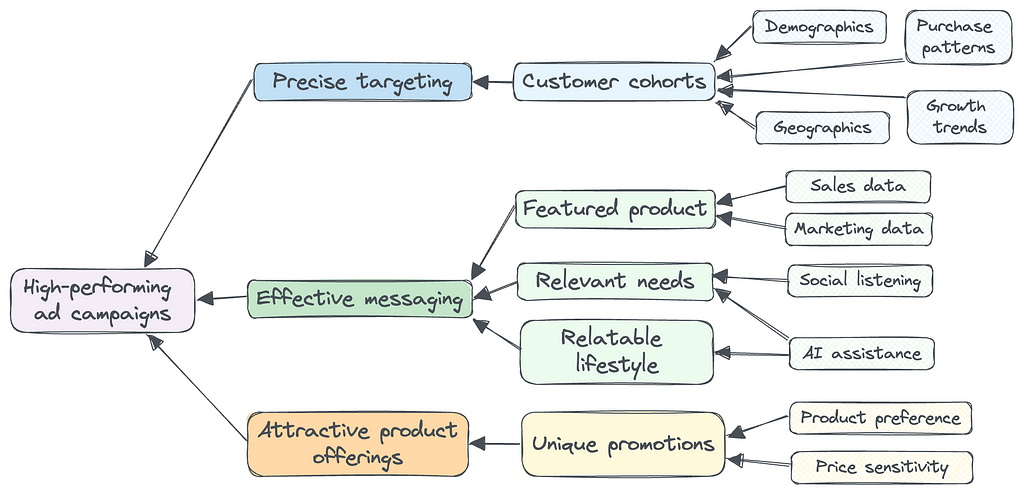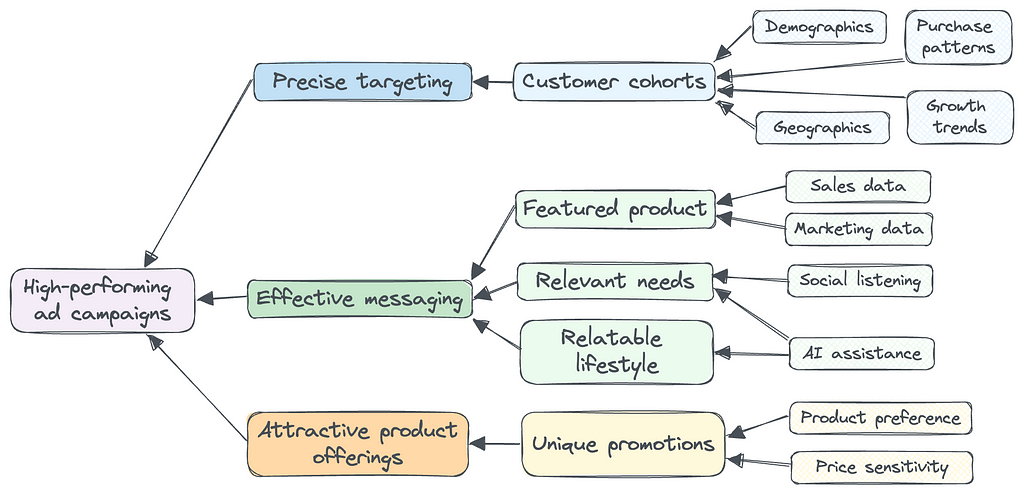
Data informed strategies help ecommerce businesses overcome advertising challenges
There’s a popular belief in the Ecommerce community that high quality creatives are all that a successful ad campaign needs. It suggests that brands should focus on making great creatives and let the ad platforms handle the rest. But in practice, it is unwise for Ecommerce businesses to blindly trust ad platforms for several reasons:
- It’s expensive for Ecommerce SMBs to build up a large history of ad performance data.
- When brands promote multiple products to multiple market segments, performance data becomes fragmented and can mislead the algorithm.
Fortunately, ecommerce executives and marketers can use data science to overcome these challenges. In this article, we will explain how ad platform algorithms work and share some practical approaches for improving customer acquisition.

How Ad Platforms Work
Ad platforms run real-time auctions to determine which ads get shown to which users. Let’s use Meta as an example. Its ad auction determines the winning ad based on the Total Value score:
Total Value = Bid × Estimated Action Rate + Relevance and Quality Score
- Bid: The amount an advertiser is willing to pay for a desired action.
- Estimated Action Rate: The predicted likelihood that a user will perform the desired action after seeing the ad.
- Relevance and Quality Score: How relevant and high-quality the ad is for the targeted user. Brands can influence this score through their ad quality and targeting.
The higher the Total Value score, the better the chances that an ad will win a spot. Additionally, a higher Relevance and Quality Score helps secure prominent placements and lowers costs.
Platforms need time (and money) to learn
Ad platforms rely on advanced machine learning models to deliver ads to the right audience. When a new ad is introduced, algorithms enter a learning phase where they collect data on user interactions with the new ad. Interactions like clicks and conversions signal positive engagement, increasing the ad’s relevance score, and leading to a positive feedback loop. After the initial learning period, algorithms continue to learn from user interactions and dynamically adjust ad placements based on the latest data.
Ad optimization is not easy
Based on our analysis, the key to improving ad performance lies in boosting the Relevance and Quality Score and optimizing how algorithms learn. But there are challenges to solving this problem:
- Ad relevance depends on both ad content and delivery. A high quality ad delivered to the wrong audience will undermine the campaign performance.
- Each ad generates its own set of performance data. Algorithms rely on large amounts of consistent ad performance data to identify the right audience for each ad.
- Ad platforms segment users to enhance ad relevance and engagement based on various factors. However, this segmentation might not always align with the ideal customer cohorts for an Ecommerce brand.
These factors have important implications for Ecommerce advertising.
Showing ads to unintended audiences wastes money
Consider a sports brand that appeals to both casual and competitive players. If the brand runs an ad for its professional gear without specific targeting, the algorithms will show the ad to a broad audience. Since ad platforms don’t segment shoppers exactly like the brand does, the ad might end up being shown to casual players, who aren’t as likely to engage with it. This lack of engagement sends negative signals to the algorithms, lowering the ad’s relevance score and making it harder to secure prime ad placements.
Frequent ad updates fragment performance data
An apparel brand might release new clothing and run promotional ads every month. Given that each ad gets a limited budget and only runs for a short period, the algorithms struggle to gather enough performance data. This makes it tough to pinpoint the best audience for each ad. Consequently, the algorithms end up showing these ads to a lot of unsuitable shoppers, which decreases the ad’s relevance score and drives up ad costs.
Large promotions disrupt algorithm learning
When brands run large promotions for special events or product launches, their ads temporarily become more appealing. Heavy discounts can attract customers who wouldn’t normally buy their products. These temporary spikes in user interaction can confuse the algorithms, leading them to misinterpret typical user behaviors. As a result, the cost per acquisition often goes up after these big promotions, forcing brands to spend significantly on ads to correct this disruption.
Tackle marketing challenges with data science
Fortunately, brands can analyze their customers’ purchase behaviors and guide ad platforms to achieve optimal results even with limited ad performance data.
Identify the right customer cohorts
When a brand runs customer segmentation, the goal is to identify distinct customer preferences for product, messaging, and promotions, so that the brand can improve its sales and marketing strategies using these customer insights.
The relevant segmentation factors can vary for each brand, so it’s important to consider as many factors as possible. Key factors in Ecommerce customer segmentation include demographics, geographics, purchase patterns, and growth trends.
Brands can use machine learning models to accurately identify customer cohorts. Once this process is complete, brands can use these customer insights to set up ad targeting and run effective campaigns.
For a sports brand I worked with, I was able to identify distinct cohorts based on factors including age, income, and level of competitiveness. One cohort was middle age adults who lived in upscale suburban neighborhoods and preferred to purchase the brand’s professional equipment. Another was young urban professionals who preferred entry-level equipment and played the sport casually. With these insights, the brand was able to precisely target different cohorts using age and location, and feature different products and sports settings in their ad campaigns for each cohort.
Design effective creatives
In addition to precise ad targeting, several factors work together to create an effective ad for each customer cohort:
- Feature the right products
Brands can identify the best products for each customer cohort from their sales and marketing data and feature different products in the ad creatives for each cohort. For a home decor brand, young customers may prefer products with vibrant colors at affordable price points, while affluent customers prefer products with luxurious designs.
- Address the relevant needs
The latest AI tools can be very helpful in providing ideas for messaging based on social listening from reviews and social media posts. For a wellness brand, young adults are likely to purchase products for fitness and energy, while older retirees look to address aging and health issues.
- Display a relatable lifestyle
Brands can infer each cohort’s lifestyle from demographic, geographic, and sales data. Again the latest AI tools can help you form a lifestyle snapshot for each of your cohorts. For recreational products, parents with young kids may respond well to creatives showing energetic families playing with the products together. Grandparents might resonate more with scenes of older people bonding with their grandchildren.
Given today’s short attention spans, ads that are most relatable to their target audience have a better chance of standing out and succeeding.
Personalize promotional offerings
Promotional discounts are more and more prevalent in today’s economy, but brands have a lot of alternatives to structure their product offerings. Many brands have told us that they know some customers don’t need discounts to make a purchase, but they’re unsure how to provide different promotions to different segments. The good news is customer segmentation and precise ad targeting provide new opportunities.
Because different customer cohorts prefer different products, one practical strategy is to offer unique promotions for each type of product. For example, an apparel brand can promote limited-edition accessories for affluent customers. Meanwhile, they might offer discounts on clothing styles that are more popular among young adults.
Successful customer acquisition is more than just creatives
High-performing ad campaigns are built on precise targeting, effective messaging, and attractive product offerings. Great creatives alone can’t guarantee success in customer acquisition. Given the many factors involved in ad optimization, brands should continuously test and learn what works the best for their unique business. Data science can help guide Ecommerce brands on this path with insightful sales and marketing strategies.
Acquire Customers with Ecommerce Data Science was originally published in Towards Data Science on Medium, where people are continuing the conversation by highlighting and responding to this story.
Originally appeared here:
Acquire Customers with Ecommerce Data Science
Go Here to Read this Fast! Acquire Customers with Ecommerce Data Science
